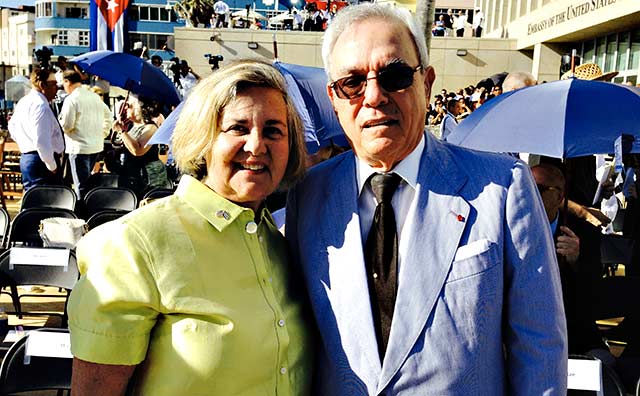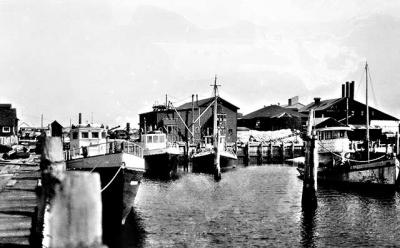Child of Cuba on Hand for Embassy Reopening
Child of Cuba on Hand for Embassy Reopening

On Friday, as United States Secretary of State John Kerry presided over the raising of the American flag over the reopened U.S. embassy in Havana, Luly Duke, an East Hampton resident who left Cuba as a girl in 1960, was on hand.An invited guest among the American and Cuban dignitaries, Ms. Duke said this week that it was “overwhelmingly exciting” to witness one of the results of President Barack Obama’s re-establishment in December of diplomatic relations with the country of her birth.The embassy was closed 54 years ago after Fidel Castro’s revolution gained control of Cuba and diplomatic relations between the two countries were severed.Ms. Duke arrived in Cuba last Thursday and early the next morning joined the crowd of about 200 gathering at the new embassy for the ceremony, which included the guests as well as a crowd of Cuban citizens on the outside of the gates looking on.It was “an amazing day,” she said Tuesday from her house overlooking Three Mile Harbor.As a girl, Ms. Duke left Cuba with her grandparents shortly after Castro took over; her parents came to the United States a year later.The family never returned to Cuba to live, but Ms. Duke has made many trips there. She established Fundacion Amistad, a nonprofit organization whose mission is to foster positive relationships between Cubans and Americans.“I’ve been working for a very long time to improve [things],” she said. “I’m so excited; I can’t tell you how excited I am.”It is amazing, she said, that it took just eight months from the time a diplomatic relationship was re-established to the reopening of the embassy, which operated for the intervening years under Swiss government jurisdiction, as the U.S. Interests Section. Now, said Ms. Duke, “They have the word ‘Embassy’ outside, with the seal” of the United States. “It was beautiful to see.” “Let me be clear: The establishment of normal diplomatic relations is not something that one government does as a favor to another; it is something that two countries do together when the citizens of both will benefit. And in this case, the reopening of our embassies is important on two levels: People-to-people and government-to-government,” said Secretary of State Kerry in his remarks at the ceremony, which was streamed live online by the State Department.Behind him, outside the embassy grounds gates, three of the vintage American cars that have endured in Cuba were parked along Havana’s seaside avenue, the Malecon, with the water — 90 miles of it separating Cuba and Key West — gleaming beyond.“The U.S. and Cuba are now finally in a place that they can discuss the issues at a higher level,” said Ms. Duke this week. “It is secretary of state to foreign minister, and ambassador to foreign minister,” she said. “And that is extremely important,” and “key to all of the negotiations.”The formation of committees, with representatives from both countries, charged with focusing on particular issues, is planned, she said.Mr. Kerry’s visit to Cuba was the first made by an American Secretary of State since 1945. Now, said Ms. Duke, “all of us are waiting for new regulations from the State Department and the Office of Foreign Assets Control to come out.” Current regulations limit visits by Americans to Cuba by restricting the spending of money there.“While a U.S. embargo on trade with Cuba remains in place and can only be lifted by congressional action,” Mr. Kerry said in his remarks last week, “the president has taken steps to ease restrictions on remittances, on exports and imports to help Cuban private entrepreneurs, on telecommunications, on family travel,” and wants “to go further.”“The goal of all of these changes is to help Cubans connect to the world and to improve their lives. And just as we are doing our part, we urge the Cuban government to make it less difficult for their citizens to start businesses, to engage in trade, access information online. The embargo has always been something of a two-way street — both sides need to remove restrictions that have been holding Cubans back,” Mr. Kerry said.The Fundacion Amistad board will meet on a retreat at the end of next month, Ms. Duke said, to develop plans for its next initiatives in Cuba, to align and assist with the expected developments growing out of new governmental policies.For instance, she said, workshops and training programs will be offered in Cuba for those interested in going into private business, an option that has heretofore been constrained.Preschool education is also a current focus. Fundacion has been supporting a preschool in Cuba for almost a decade but is working to expand early childhood education in the country, where it is not generally offered. The group is collaborating with the Ross School in East Hampton to establish a preschool at the Havana Cathedral church, and this week, said Ms. Duke, four Cuban teachers are here, attending a preschool teacher training session at Ross.In his remarks at the ceremony, Mr. Kerry singled out the work done by Ms. Duke and others like her in attendance.“We also want to acknowledge the special role that the Cuban American community is playing in establishing a new relationship between our countries,” he said. “And in fact, we have with us this morning representatives from that community, some of whom were born here and others who were born in the United States. With their strong ties of culture and family, they can contribute much to the spirit of bilateral cooperation and progress that we are seeking to create, just as they have contributed much to their communities in their adopted land.”“But above all, above all, I want to pay tribute to the people of Cuba and to the Cuban American community in the United States,” he said.Mr. Kerry quoted Jose Marti, a beloved Cuban poet: “Jose Marti once said that ‘everything that divides men . . . is a sin against humanity.’ ”To Ms. Duke, Mr. Kerry’s comments were “very properly positioned and very properly well said.”“Matters of the Sea,” or “Cosas del Mar,” in Spanish, a poem written for the occasion and read by Richard Blanco, an American poet whose family is Cuban, “was spectacular,” Ms. Duke said. The poem addresses “the chance for all of us to see each other as human beings.”In attendance to hand over the new American flag that was hoisted last week were the three U.S. Marines who, in removing the American flag at the embassy’s closure so many years ago, had vowed one day to see it go up again. That, Ms. Duke said, “was so emotional and beautiful.”A brass band played Cuban music of the 1950s, including a mambo, and there was dancing at the ceremony, Ms. Duke said. “It was an amazing experience; I’m very grateful and honored to have been there.”“I am very excited; I think a lot of new and good things are going to come to the Cuban people.”


